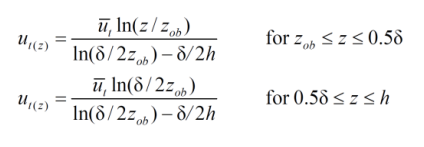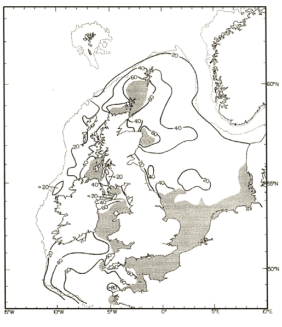Friction with the sea bed causes currents to diminish progressively as the bed is approached, until at the bed itself the velocity is effectively zero. The height to which the influence of bottom friction is felt in this way is known as the boundary-layer thickness.
In deep water with slow currents, the boundary layer occupies a thin layer near the bottom, while above it the current is frictionless and hence constant with height. In shallow water with fast currents, the boundary layer generally occupies the entire water depth. In the upper half of the
boundary layer, the currents vary only slightly with height, and can to a reasonable approximation be taken as being constant with height.
Two alternative procedures may be used to predict the tidal current t (z) u as a function of height z above the bed in water depth h, assuming that the depth-average current t u is known. They are intended primarily to be applied to tidal flows over a flat (but possibly rippled) bed in water which is uniform in temperature from surface to bottom (i.e. unstratified).
Method 1
The following simple two-part formula is found to give a good fit
to profiles measured in a wide variety of locations:
This method will give a rough indication of the current profile, usually accurate to within ±15%,
even in cases where the temperature is not homogeneous or where the bed is not flat. However it may be less accurate very near to the bed and also in areas with a thin boundary layer, such as the North Sea north of 55°N and the shelf to the west of Britain.
Method 2
This is a more site specific procedure, and also gives better accuracy near to the sea bed. The nature of the bed determines the roughness length zob given in table
1. The boundary-layer thickness ∂ is contoured in Figure 1 for the seas surrounding the British Isles. In the shaded regions and in coastal regions shallower than 20m, ∂ should be set equal to the water depth h. The current profile is then given by the following two-part formula:

In reality the profile merges smoothly from one equation to the other. In order to benefit from the greater accuracy (better than ±5%) of this method it should be applied only to the maximum M2component of current in an unstratified flow over a flat bed.
Typical Values For Roughness Length
Nature of sea bed zob (m)
Mud 0.2 × 10-3
Mud/sand 0.7 × 10-3
Silt/sand 0.05 × 10-3
Sand (unrippled) 0.4 × 10-3
Sand (rippled) 6.0 × 10-3
Sand/shell 0.3 × 10-3
Sand/gravel 0.3 × 10-3
Mud/sand/gravel 0.3 × 10-3
Gravel 3.0 × 10-3
Boundary Layer Thickness

